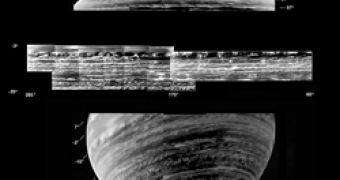Cassini scientists studying Saturn's rings have made several new findings that further our knowledge of how this beautiful and dynamic system continues to evolve before our eyes.
"Understanding the dynamics of Saturn's rings provides on a miniature scale a better understanding of how our solar system formed from a disk of particles surrounding the Sun," said Dr. Jeff Cuzzi, Cassini interdisciplinary scientist, NASA Ames Research Center, Moffett Field, Calif.
Cassini's composite infrared spectrometer has found that particles within Saturn's main rings (the A, B, and C rings) are spinning slower than anticipated. This occurs even in areas where particles are so densely packed that they frequently bump into each other and where researchers expected them to spin quicker. From the planet outward, the order of Saturn's rings is D, C, B, A, F, G and E. The rings were assigned a letter in the order they were discovered
"It would be wonderful if we could scoop up a ring particle and bring it back to Earth to study it but we can't do that, so using an instrument like this one can help reveal what a ring particle might actually look like," said Dr. Linda Spilker, deputy project scientist for the Cassini-Huygens mission at NASA's Jet Propulsion Laboratory, Pasadena, Calif. "A ring particle probably looks more like a fluffy snowball than like a hard ice cube," she said.
"The spacing between the clumps is greater than the widths of the clumps themselves," said Dr. Joshua Colwell, team member of the ultraviolet imaging spectrograph, University of Colorado, Boulder. "If we could get close enough to the rings, these clumps would appear as short, flattened strands of spiral arms with very few particles between them."
Imaging scientists have also made some surprising discoveries. Part of the D ring (the ring closest to Saturn) has gotten dimmer and moved inward, toward Saturn, by about 200 kilometers (125 miles), since it was observed by NASA's Voyager spacecraft, some 25 years ago.
Dr. Matt Hedman, an imaging team associate at Cornell University, Ithaca, N.Y. said, "Cassini's high resolution images of the D ring are providing new information about the dynamics and lifetimes of ring particles in a new regime, very close to the planet."
Among their biggest surprise is that a spiral ring encircles the planet like a spring. This unexpected "spiral arm" feature exists in the vicinity of the F ring and actually crosses the F ring's orbit.

 14 DAY TRIAL //
14 DAY TRIAL //